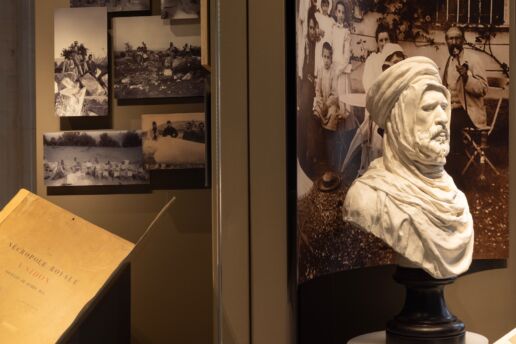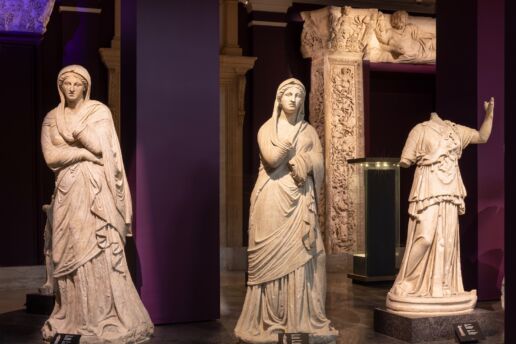THE GREAT TREASURY OF THE HISTORY OF VANISHED PEOPLES1
As the first museum in the Ottoman Empire and the Republic of Turkey, the Istanbul Archaeological Museum is a landmark institution with a powerful image that has withstood regimes and time. It is the keeper of relics from a mosaic of cultures that inhabited the lands that were once part of the crumbling imperium. PAPER would like to say "eline sağlık" to Osman Hamdi Bey, who was the first director to make it a great institution on the world stage and to leave all of us an invaluable legacy.Photography Nazlı Erdemirel
Osman Hamdi Bey Yokuşu is the street that ascends gently towards Topkapı Palace among the ancient trees in Gülhane Park. The street is named for one of the most important cultural figures in Turkish history. Just to the left of this street, waiting like a treasure to be discovered, stands the Istanbul Archaeological Museum, one of the most trusted guardian of artefacts from past civilisations. As one of the museum’s late 19th century directors, Osman Hamdi was the one who transformed it from a collection of objects into a cultural treasure. Today, the atmosphere beyond the gates and inside the grounds is hushed. You can almost hear the stone statues whispering among the marble columns and sarcophagi on plein air display. This cultural complex consists of the Museum of Islamic Art (in the Tiled Kiosk), the Museum of the Ancient Orient (in the Ancient College of Fine Arts building) and the Archaeological Museum (in the main building). Yet the history in its gardens alone is the stuff of legends.
OSMAN HAMDI BEY TURNS THE IAM INTO A WORLD-CLASS MUSEUM
Establishing the Istanbul Archaeological Museums (or the Imperial Museum) was a challenging task, considering it was the first of its kind and created during a period of political upheaval. It was the first museum in the Ottoman Empire and still the first by the time the Republic of Turkey was born among the empire’s ruins. A landmark institution with a powerful image that has withstood regimes and time, it has become the caretaker of artefacts, tracing the mosaic of cultures that once inhabited the vast Ottoman realm.
It is no coincidence that, along with the museum, we commemorate its most important administrator, Osman Hamdi. This is because he transformed a fledgling institution into one of the world’s leading museums. The stories of the museum and Osman Hamdi Bey are intertwined with the history of the period. His father, İbrahim Edhem Pasha, was one of the first people sent by the Ottoman Empire to France for formal education and a statesman who eventually rose to the rank of Grand Vizier. Osman was born in 1842 and raised as an intellectual. Like his father, he went to Paris, where he studied painting and law. On his return, he took on various official positions: foreign affairs director, exhibition commissioner, diplomat and even mayor.
In the late 19th century, the rulers of the politically and militarily frail Ottoman Empire had turned to Europe, where the bourgeoisie was in power after the Industrial Revolution and major social transformations were giving birth to new national identities. Improved maritime and railway networks increased the circulation of people and goods significantly.This, and the spread of printing technology, helped to standardise and communicate information across great distances.Meanwhile, governments raced to open national history museums in order to write history on their own terms. In its search for an identity, Europe turned to its Greco-Roman past and, in the process, established the concept of cultural heritage and the scientific disciplines of archeology and museology. Unsurprisingly, for many Westerners in the city, Istanbul was invaluable to their new identities. In the late Ottoman period, the progressive administration was trying to reinvent itself in every milieu, including culture. It was during this period that Sultan Abdülmecid asked the Fossati Brothers to restore Hagia Sophia, allowed Western scientists to conduct studies in the city, and organised the exhibition of cultural artefacts at the Paris Exposition. The growing interest in museums is linked to this initiative and Europe’s fascination with the Empire.
The first official mention of a museum as a concept in the Ottoman Empire was in 1869. This was the Müze-i Hümayun(Imperial Museum), which used the Hagia Irene Church as a venue to exhibit a collection of weapons and antiquities. The archaeological artefacts in the church were moved to the Tiled Kiosk in 1875 to form the core of the Archaeological Museums. (This köşk was built in 1472. One of the earliest Ottoman buildings still standing in Istanbul, it was built during the reign of Mehmet II and currently contains artefacts from the Seljuk and Ottoman periods.) On Osman Hamdi’s initiative, the classical building opposite the Tiled Kiosk opened on June 13, 1891, the second of the museum’s three buildings today.
Since its establishment in 1869, the museum had been managed by foreign administrators endorsed by Western nations. Hamdi’s appointment as director signalled an important change in the government’s lax policies concerning the treatment of antiquities. The first half of the 19th century, in particular, was a time when the West was literally looting archeological remains across Ottoman territory, often with the consent of its rulers. It was during this period, for example, that the Zeus Altar in Pergamon was dismantled and transported to Berlin, the Nereids Monument and the Knidos Lion to the British Museum and a significant section of the Temple of Athena in Assos to the Louvre.
The first regulation on antiquities (Asar-ı Atika Nizamnamesi) was enacted after the museum was officially established in 1869, but its scope was limited. An updated regulation in 1874 introduced tighter measures, but they had little impact. New regulations established in 1884 and chiefly written by Hamdi, however, increased the Empire’s control over antiquities and placed severe restrictions on their removal from the country. In a letter written to Vincent Caillard, the President of the Ottoman Public Debt Council, Hamdi sounds triumphant about the safeguarding of the country’s heritage: “The Chaldeans, the Assyrians, the Hittites, the Aramaeans, the Phoenicians, the Nabatzaeans, the Carians, the Phrygians, the Ionians – in a word, all of these peoples who formerly inhabited the territories which now form the Turkish Empire – have left traces of their civilisations buried in the soil. Any stroke of a pickaxe might bring to light some precious object or inscription full of historic or artistic interest, every one of which will travel the road to the Imperial Museum. Already that road is beginning to be well worn and levelled by this new traffic. On its arrival there, each object will find the place indicated for it by science or art and, within 50 years, the Museum of Constantinople will be the Great Treasury of the history of vanished peoples, the grand depository of the products of their genius.”[2]
THE ARCHEOLOGY MUSEUM, DESIGNED BY ALEXANDER VALLAURY, BECOMES ONE OF THE WORLD’S FIRST BUILDINGS DESIGNED TO SERVE AS A MUSEUM
Hamdi focused on archeological excavations to uncover the great treasures he mentioned in his letter. He directed the excavations of Sidon, Lebanon in 1887, which revealed a necropolis belonging to the Phoenician kings and wonderful artefacts, including the Alexander Sarcophagus, Sarcophagus of the Mourning Women, the Satrap Sarcophagus and the Sarcophagus of King Tabnit, which were painstakingly transported to Istanbul. Hamdi also excavated the necropolises of Nemrut, Myrina, Kyme and Aiolia, as well as the Temple of Hekate in Lagina. Soon, the Tiled Kiosk could not contain this rapidly growing collection. The public fascination with the sarcophagi helped Hamdi secure the support of Sultan Abdulhamid II for the construction of a new building. Opened in 1891 and designed by Alexander Vallaury, a French-Ottoman architect teaching at the School of Fine Arts, the Archeology Museum became one the first buildings in the world conceived as a museum. As one of the most important neoclassical buildings in Istanbul, the building’s façade is reminiscent of a temple with a wide staircase at the entrance and columns and pediments inspired by the Sarcophagus of the Mourning Women. The triangular pediment bears the inscription “Asar-ı Atika Museum” in Ottoman Turkish with the signature of Abdulhamid II, who had it built. The addition of the right wing in 1904 and the left wing in 1908 increased the exhibition area to over 3,000 square metres.
The main museum building contains Greek and Roman funerary stelae, temple friezes, sculptures, artefacts from the Sidon excavations, archaic, Hellenistic, Roman, and Byzantine objects, and an extensive collection of cuneiform documents. The Osman Hamdi Bey Hall inside contains an exhibition about his work in museology, painting and archeology.
With approximately 50,000 books and 2,000 manuscripts, the Archaeological Museum’s library is equally important. With its classic 19th-century bookcases, tables and railings, the library was established with donations and books acquired or ordered by Osman Hamdi through his extensive contacts in Europe.
The third building in the Istanbul Archaeological Museum complex is the Museum of the Ancient Orient, which can also be attributed to his efforts. In 1882, he was appointed director of an Academy of Fine Arts that did not yet exist and tasked by Sultan Abdulhamid II with founding the first arts school in the Ottoman Empire. Hamdi thought the Academy should be close to the museum and built the building known today as the Museum of the Ancient Orient. This building served as a school from 1883 until 1917, when it was converted into a museum because it hosted collections from pre-Greek Anatolia and Mesopotamia, pre-Islamic Egypt and the Arabian Peninsula.
Since its founding, the museum’s collection has grown from approximately 650 artefacts, during Hamdi’s time, to more than one million today, making it a stark reminder of the priceless heritage of a city like Istanbul and the important role of the museum in preserving it. Osman Hamdi served as the director until he died in 1910. As an artist, academic, field archeologist and administrator he left an astonishing legacy of which the Istanbul Archaeological Museums are only a part. His name will live on in them for generations to come.
1 Osman Hamdi’s description of the museum in his letter to Vincent Caillard.
2 Zeynep Çelik, “About Antiquities: Politics of Archaeology in the Ottoman Empire”, University of Texas Press.
















